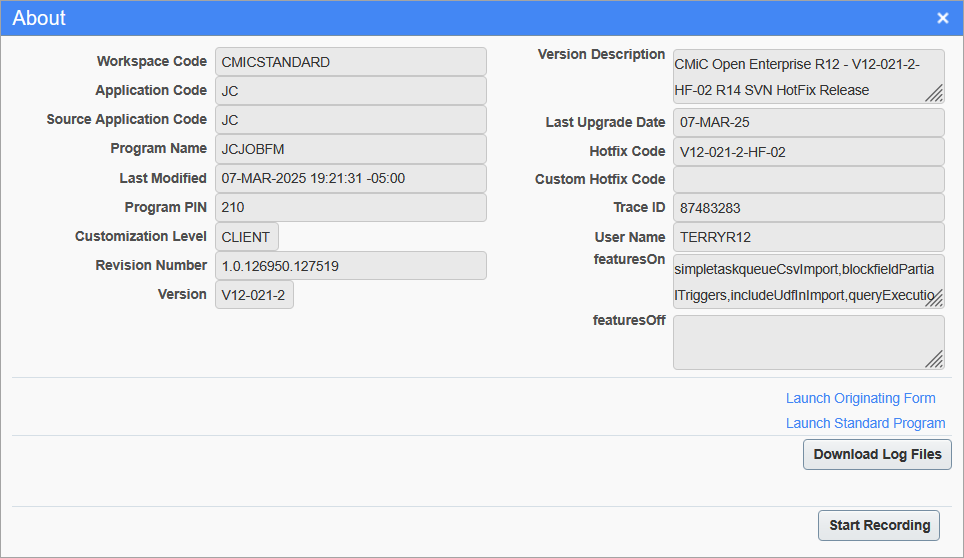
The About (![]() ) icon, on the Menu Toolbar, displays information about the current module and the editing privileges of its current user. It also displays the name of a selected table or field. This function is particularly useful to retrieve information about the current application in case you need to communicate with CMiC about it.
) icon, on the Menu Toolbar, displays information about the current module and the editing privileges of its current user. It also displays the name of a selected table or field. This function is particularly useful to retrieve information about the current application in case you need to communicate with CMiC about it.
The About screen provides essential technical details about your CMiC environment. If a program selected version is selected, it also provides detailed metadata about the specific CMiC program currently in use. This information is useful for troubleshooting, support requests, and understanding your current system configuration.
The following describes the fields available on this screen.
Workspace Code
This field identifies the workspace or environment context.
Application Code
The code for the application module, depending on the opened program.
Source Application Code
This field indicates the originating application module, depending on the opened program.
Program Name
The internal name of the program or form.
Last Modified
The timestamp of the last modification to the program.
Program PIN
A unique identifier for the program version.
Customization Level
This field indicates whether the program is standard or customized.
Revision Number
The internal build number of the current deployment.
Version
The official version number of the CMiC platform.
Version Description
A detailed description of the version, including release type and environment.
Last Upgrade Date
The most recent date your environment was upgraded.
Hotfix Code
This field identifies the standard hotfix applied to your environment.
Custom Hotfix Code
This field identifies any custom hotfixes applied.
Trace ID
A unique identifier used for tracking and diagnostics.
User Name
This field displays the current user session.
featuresOn
This field lists enabled feature flags that may affect system behavior.
featuresOff
This field lists disabled feature flags.
Launch Standard Program
Click this link to open the standard version of the current program. This is helpful for comparing custom vs. standard behavior, verifying if issues are related to customizations, and testing baseline functionality.
[Download Log Files] − Button
![Sample of the Select Files pop-up window after clicking the [Download Log Files] button](../../../../Resources/Images/GettingStarted_12c/DownloadLogFilesButton.png)
The [Download Log Files] button is used to download system-generated log files. These logs are essential tools for CMiC to diagnose issues, review system activity, and validate system performance over time. Permission to download server logs is granted through the UIDWNLOGS system privilege in the User Maintenance screen.
The Download Log Files feature in CMiC provides users with a streamlined way to collect and export system logs and configuration data. When users encounter unexpected behavior or errors, downloading logs provides critical insight into what’s happening behind the scenes. These logs can be shared with CMiC Support to accelerate issue resolution.
Clicking the [Download Log Files] button opens the Select Files panel, where you can choose which types of files to include in your download package. When sending logs to CMiC Support, set the Select Additional Files drop-down list to "All" before clicking the [Download] button.
The following describes the file types listed in the Select Additional Files drop-down list.
-
All: Selects every available file type.
-
Server Information: Includes server metadata and environment details.
-
Configuration Files: Captures system configuration settings.
-
All Logs: Bundles all available log types.
-
Diagnostic Log: Contains detailed system diagnostics
-
Out File: Includes output logs from various processes.
-
Access Log: Tracks user access and activity.
-
Jasper Log: Logs related to JasperReports or reporting services
[Start Recording] − Button
![Sample of the [Start Recording] button](../../../../Resources/Images/GettingStarted_12c/StartRecordingButton.png)
The [Start Recording] button initiates a session recording that captures user interactions within the application. This is especially useful for things like troubleshooting complex issues, demonstrating bugs or unexpected behavior, and creating training or documentation materials. Permission to record your screen from within CMiC is granted through the UISCRREC system privilege in the User Maintenance screen.
When you click the [Start Recording] button, a pop-up in your browser allows you to configure the recording settings to your choosing. When finished, CMiC begins capturing your session activity, including:
-
Navigation between screens
-
Data entry and form interactions
-
Button clicks and menu selections
This recording can later be reviewed by support teams or used internally for training and process validation. Please note that the recording will last up to two minutes in length. Also, the CMiC Support portal supports a file size of up to 50 MB.
![Sample of the [Stop Sharing] button](../../../../Resources/Images/GettingStarted_12c/StopSharingButton.png)
To end the recording, you can either click on the [Stop Sharing] button (shown in the above screenshot) or open the About screen again and select the [Stop Recording] button next to the [Start Recording] button, as shown in the screenshot below.
![Sample of the [Stop Recording] button on the About screen](../../../../Resources/Images/GettingStarted_12c/StopRecordingButton.png)
Examples of use cases are as follows:
-
Troubleshooting: Record a session where an issue occurs and share it with CMiC Support for faster resolution.
-
Training: Demonstrate workflows or processes for onboarding new users.
-
Documentation: Capture step-by-step actions for creating internal guides or standard operating procedures.
For best practices:
-
Start recording before reproducing an issue or demonstrating a process.
-
Keep recordings focused and concise to make them easier to review.
-
Use the [Download Log Files] button in tandem for a complete diagnostic package.